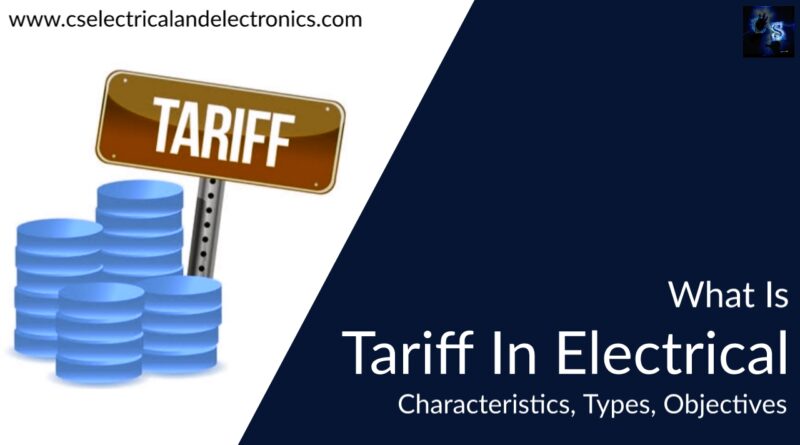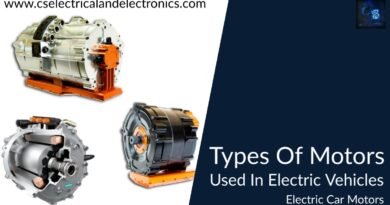What Is Tariff In Electrical, Characteristics, Types Of Tariff, Benefits
Hello guys, welcome back to my blog. In this article, I will discuss what is tariff in electrical, characteristics, types of tariff, advantages, disadvantages, the main objectives of it.
If you have any doubts related to electrical, electronics, and computer science, then ask questions. You can also catch me @ Instagram – Chetan Shidling.
Also, read:
- Top Types Of Testing On Power Transformers Done Before Use
- Top 10 Amazing Autonomous Vehicles Makers That Will Attract You
- Top 10 Different Power Plants In The World, Hydro, Solar, Wind, Thermal
What Is Tariff In Electrical
The rate or charge at which electrical energy is supplied to a consumer is known as “Tariff”. The electrical supplier produces electrical energy in the power station and is delivered to various consumers. These suppliers invest capital costs on equipment, land, building, etc., and they derive income from consumers through electricity bills. The different methods of charging consumers are known as tariffs. The tariff should be such that, it not only recovers the total cost of producing electrical energy but also earns profit on the capital investment.
The main objective of tariffs is to recover various investments in the production of electrical energy. The tariff should fulfill the following items.
- Recovery of the cost of capital investments in generation. Transmission and distribution of equipment.
- Recovery of the cost of operation, supplies, maintenance, and losses.
- Recovery of the cost of metering, billing collection, and miscellaneous services.
- A satisfactory net return on the capital investment.
Characteristics Of Tariff
- The electrical energy supply is different from other forms of business. Hence, the following factors will be taken into account while fixing the Tariff.
- It is not possible to store electricity in huge amounts. Hence, the tariff should be such that, it ensures proper returns from each consumer.
- Electrical energy must be available whenever needed. Hence, tariffs should earn sufficient money to meet the instant demand.
- The various consumers are encouraged to make effective and efficient use of electricity.
- The tariff should be fair in order to satisfy the different types of consumers.
- The tariff should be designed simply such that an ordinary consumer can easily understand it.
- The tariff should be uniform over a large population.
- It should have a provision of charging a penalty for consumers at the low power factor.
- It should provide an incentive for using electrical energy during off-peak hours.
- A big consumer should be charged at a lower rate than a smaller consumer because the increase in the use of electricity decreases the cost of generation per unit.
- The suppliers have control up over the electricity meter. Hence the use of electricity by consumers cannot be controlled.
Types Of Tariff
There are mainly six types of tariffs. A large number of tariffs have been proposed from time to time, but the following are some of the tariffs which are in common use.
01. Simple Tariffs (or) Uniform Tariffs:- if the rate or charge per unit of electrical energy consumed is fixed, such a tariff is known as simple or uniform tariffs.
This is the simple type of tariff in which the cost of energy consumed is charged on the basis of the number of units consumed. The cost per unit charge is as follows.

Advantages:
- It is the simplest type of tariff and easy to understand.
- Calculation is easy.
Disadvantages:
- The cost per unit delivered will be higher.
- No discrimination between domestic (small) consumer and bulk consumers, hence all consumers have to pay equality for the fixed
- charges.
- It does not encourage the use of electricity
02. Flat Rate Tariff: If the different types of consumers are charged at different rates per unit of energy consumed, such a tariff is known as a flat-rate tariff.
In this type, the consumers are classified into different classes (such as domestic, industrial, public, etc) and each class of consumer is charged at different rates. The different class of consumers is made by taking into account their load factors and diversity factors. If the consumer has two types of loads, say (1) Lighting loads (light and fan, etc) and (2) power loads, then two meters are to be installed at his premises, one for lighting load and another for power load. The Flat rate per kWh(unit) for lighting load may be slightly higher than the power load. Suppose the rate per kWh.
03. Block Rate Tariff:
If one block of energy is charged at a specified rate and the next block of energy is charged at reduced rates, such a tariff is known as a Block rate tariff. In this type of tariff, the energy consumption is divided into blocks. The cost per unit in the first block is high and the cost per unit in the next block is progressively reduced. Hence, the consumer who consumes large units has to pay less as compared to the consumer who consumes fewer units.
For example in a domestic the total number of units is 100, then the first 30 units nay is charged @60 paise per unit, the next 50 units nay be charged @50 paise per unit, the remaining 20 units may be charged @30 paise per unit, then, the total bill will be 3060+5050+20*30=4900 paise= rs. 49/-
04. Two-Part Tariff:
If the consumers are charged on the basis of maximum demand and units consumed, such a tariff is known as a Two-part Tariff. In this type of Tariff, the total charges per unit are split into two types namely fixed charges and running charges. Fixed charges are proportional to maximum demand (KW) and running charges are proportional to the number of units consumed (KWH). Generally, this Tariff is expressed as
Total charges= Rs. (aKW + bKWH)
A= charge per KW of maximum demand
B= charge per kWh of energy consumed
05. Maximum Demand Tariff:
This tariff is similar to a two-part tariff except that, in this case, the maximum demand is actually measured by using a maximum demand meter installed at the premises of the consumer. If a consumer does not consume energy for a month the maximum demand meter reads Zero, Hence, the drawback of a two-part tariff can be eliminated. This tariff is mainly applicable to large industrial consumers, but not suitable for the small consumers as it requires a separate maximum demand meter.
06. Power Factor Tariif:
If the power factor of the consumer’s load is taken into consideration, such a tariff is known as a power factor tariff. The efficiency of plants and equipment depends on the power factor. Hence in order to increase the utility of plant and equipment to the maximum possible extent, the plant must be operated at the most economical power factor. So, the supplier has to encourage the consumer to operate the load at a low power factor.
- KVA maximum demand tariff
- Kwh and KVARh tariff
- Sliding scale or Average power factor tariff
This was about ” What Is Tariff In Electrical “. I hope this article may help you all a lot. Thank you for reading.
Also, read:
- 10 Tips To Maintain Battery For Long Life, Battery Maintainance
- 10 Tips To Save Electricity Bills, Save Money By Saving Electricity
- 100 (AI) Artificial Intelligence Applications In The Automotive Industry
- 100 + Electrical Engineering Projects For Students, Engineers
- 1000+ Control System Quiz, Top MCQ On Control System
- 1000+ Electrical Machines Quiz, Top MCQs On Electrical Machines
- 1000+ MATLAB Simulink Projects For MTech, Engineering Students
- 50 Tips To Save Electricity At Home, Shop, Industry, Office
Author Profile
- Chetu
- Interest's ~ Engineering | Entrepreneurship | Politics | History | Travelling | Content Writing | Technology | Cooking
Latest entries
 All PostsApril 29, 2024Top 11 Free Courses On Battery For Engineers With Documents
All PostsApril 29, 2024Top 11 Free Courses On Battery For Engineers With Documents All PostsApril 19, 2024What Is Vector CANoe Tool, Why It Is Used In The Automotive Industry
All PostsApril 19, 2024What Is Vector CANoe Tool, Why It Is Used In The Automotive Industry All PostsApril 13, 2024What Is TCM, Transmission Control Module, Working, Purpose,
All PostsApril 13, 2024What Is TCM, Transmission Control Module, Working, Purpose, All PostsApril 12, 2024Top 100 HiL hardware in loop Interview Questions With Answers For Engineers
All PostsApril 12, 2024Top 100 HiL hardware in loop Interview Questions With Answers For Engineers








